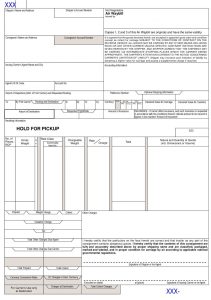Air Waybill: What It Is and Why It’s Important
In the air shipping process, an air waybill (AWB) is a vital document that serves many essential functions. Primarily, it contains detailed information regarding the goods being transported and where they are to be delivered. Without this information, the cargo stands a high chance of being mishandled or even lost in transit.
Details Within the Air Waybill
An air waybill is ultimately a standardized one-page form that accompanies goods being shipped via airplane. It contains essential information pertinent to the movement of the intended cargo, including:
- Shipper’s name and address
 Recipient’s name and address
Recipient’s name and address- Carrier’s name and office address
- Description of goods being transported and their declared value
- Quantity, weight and size of packaged goods
- Airport of departure
- Airport of destination
- Special handling instructions, if any (i.e. refrigeration required)
- Terms and conditions of the transportation contract
Every air waybill also includes an AWB number. This unique 11-digit number is divided into three sections. The first three digits identify the carrier by numbers assigned to them through the IATA index. The next seven digits make up the AWB’s serial number. The last digit, or check digit, is calculated by dividing the serial number by seven.
The AWB number is used to secure bookings and enable tracking of the status and location of the shipment.
AWB: One Form, Many Colors
There are primarily three parties involved in the transfer of goods as detailed in an air waybill. The consignor, or shipper of the goods is first. Second is the carrier, or the airline transporting the goods. Last is the consignee, which is the recipient. Each receives a copy of the AWB.
The air waybill is designed and distributed by the International Air Transport Association (IATA). It is used in both domestic and international shipping. The form itself is comprised of eight sets of different colors. The first three copies are considered originals.
- Green – completed and retained by issuing carrier
- Pink – retained by consignee (recipient)
- Blue – retained by consignor (shipper)
- Brown – serves as receipt and proof of delivery
- White x 4 – additional copies to be kept by the consignor for various purposes
Succession of the Air Waybill
Before freight can be shipped by airplane, the consignor (or agent working on their behalf) fills out an AWB. Subsequently, the carrier issues the air waybill upon receipt of the goods and completion of any necessary export customs procedures.
At this time, the consignor receives their copies of the AWB as proof of receipt of goods by the carrier. The AWB then travels with the freight, through import customs clearance, if necessary, to the destination.
Upon arrival at destination, the consignee (or their agent) inspects the freight and collects their copy of the air waybill.
Functions of the Air Waybill
Though one form, the AWB fulfills a variety of important functions:
- It is a legal contract of carriage between the shipper and carrier (airline).
- Also serves as proof of receipt of goods for shipment by the carrier.
- Recognized as the freight bill, as it details the freight and ancillary charges involved.
- Becomes record of contact information for all parties involved.
- Works as a guide for handling and delivery of goods.
- Accepted as a customs declaration document.
Electronic Air Waybill
An alternative to the printed air waybill is its digital counterpart, the electronic air waybill (eAWB). Approved and implemented by IATA in 2019, the eAWB has many benefits. It eliminates the need to print, handle, and archive paper air waybills. It also contributes to faster delivery times and decreased handling errors.
Not only does the eAWB process save time and money, it’s also environmentally friendly, as it reduces paper usage.
One limitation to the eAWB involves the shipment of dangerous goods (DG) or hazardous materials. Per IATA regulations, substances in these categories require the appropriate documentation to be in paper form. Electronic air waybills cannot be accepted for these types of shipments.
Air Waybill vs. Bill of Lading
An air waybill and bill of lading are both legal documents between a shipper and a carrier. They each provide details on the goods being shipped, how the goods are to be handled, and what their destination is. This is where their similarities end.
One of the main differences between these two documents is that an air waybill is used specifically for freight being shipped by air, while a bill of lading is used for freight shipped by ground, air or sea.
Also, unlike a bill of lading, an AWB does not serve as proof of ownership of goods being shipped. It is simply a contract for transportation of the goods.
Another distinction of the AWB is that, contrary to the bill of lading, it is a non-negotiable instrument. This means that it does not specify the exact flight the cargo will be shipped on, or when it will arrive at its destination.
Air Shipping Expertise: Here For You
Finding the best air freight option and navigating through the steps of transporting goods can be difficult. At Grand Aire, we utilize our 35+ years’ experience to make this task easier. Our Logistics Specialists are accessible 24/7/365 to assist with your air shipping needs. For more information, give us a call at 1-800-70-GRAND or email our team at logistics@grandaire.com.
